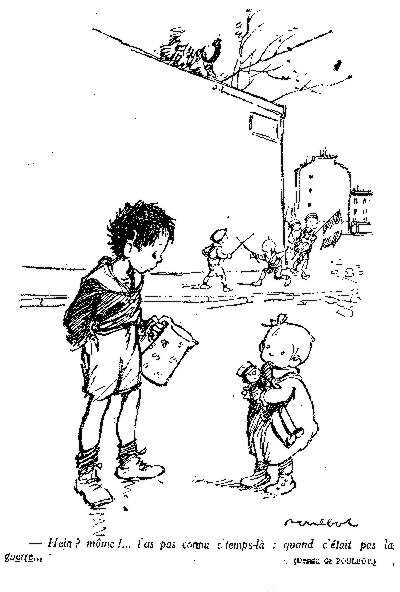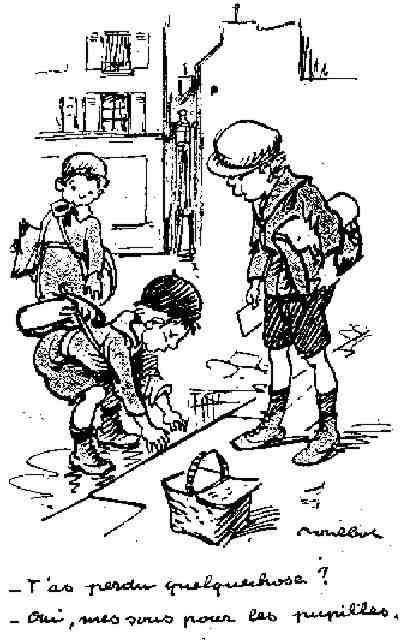
Illustrators: Francisque Poulbot (France, 1879-1946)

Figure 1.--This Poulbot image was published as a postcard during World War I (1914-18). They were propaganda images to maintain French morale during this horrible period. They may shock our German readers, but they are a testimony of the time. The caption reads, "Hein? Môme !... T'as pas connu ce temps là : quand c'était pas la guerre ...." ("Huh, kid? Things aren't like the old days, when there wasn't a war.")
|
Francisque Poulbot is one of the most famous French illustrators, especially illustrators of children. Poulbot is particularly known for his drawings of Paris street urchins. Poulbot loved to draw these children as shameless, and often malicious jokesters. Most of Poulbot's work was published in the 1900s-30s. He died in 1946. Given his many anti-German drawings, I'm unsure what happened to him during the German occupation. Many of Poulbot's drawings were sharply aimed at the Germans (le bosch) during World War I (1914-18). Poulbot's drawings illustrate well and highlight the clothes worn by children in the early 20th century.
English Text
Biography
Francisque Poulbot was born in Paris in 1879. He was the son of a Wire of a school principal in Saint-Denis. Francisque would dissapear during recesses to admire the drawings of Toulouse-Lautrec and Steinlen
in the cabaret Mirliton. From these experiences dates his future vocation.
Subjects
Poulbot is especially known for his drawings of Paris street urchins. Poulbot loved to draw these children as shameless, vulgar ("gouailleurs"), and malicious jokesters whom one finds in the "Gavroche" of the "poor wretches" of Victor Hugo. A French readers tells us that "gouailleur" means scoffer, mocker and vulgar. Poulbot is the father of the "gavroche" montmartrois which now bears his name. Today, in France, to refer to these children of the streets of Montmartre one says either: a "gavroche", "a Parisian kid" or "a poulbot".
Career
Poulbot was a natural humorist naturalist and published regularly, obtaining great popular success. He "tenderized" the image of Paris street urchins. His images appeared in magazines, postcards (very popular at the time), and advertizing. His drawings were not limited solely to images of street urchins. He also did a little writing and illiustrated the work of several famous authors.
Chronology
Most of Poulbot's work was published in the 1900s-30s. He died in 1946. Given his many anti-German drawings, I'm unsure what happened to him during the German occupation.

Figure 2.--This Poulbot image was published as a postcard aftet World War I. These illustrations with the legend which accompanies
them tell bitter-sweet stories. They mention problems if not dramas of these times. The cation reads, "- T'as perdu quelque chose?
- Oui, mes sous pour les pupilles." (- You lost something? - Yes, my sous (coins) for the pupils." "The pupils" or more precisely "the War orphans" are, in France, the children who lost their fathers in the war. The French Government took responsibility for its the expenses of
educating these children. But at the end of World War I, France was financially ruined by the War effort and funds available for the large number of War orphans was insufficient. Many private groups organized money collections to assistance the widows and the orphans.
|
World War I
Many of Poulbot's drawings were sharply aimed at the Germans ("le bosch
") during World War I (1914-18). One is reminded of Hansi's drawings about Alsace after the Franco-Prussian War (1870-71). Poulbot provided captions for many of his drawings. They are understanable only in the context of the time. At the time of World War I, French hated of the Germans was intense. France had lost two provinces in the Franco-Prussian War, Alsace and Lorraine.
As a result, since 1870 all French boys were educated in a spirit of revenge and reconquest of these two provinces. These feelings were exacerbated as the War progressed because of the battlefield carnage.
Reputation
The most famous French illustrator of childhood is probably Pierre Joubert. He had a notable prdecessor in Francisque Poulbot who was also an illustrator of
childhood. A French reader mentioned that he like Pierre Jobert uses humor in his drawings. Although wll known in France, Poulbot is little-known outside of France. Joubert became known in other countries because of his Scouting work. In addition many of the books Joubert illustrated were translated for sale in other countries.
Clothing illustrated
Poulbot's drawings illustrate well and highlight the clothes worn by children in the early 20th century. One French reader reports that Poulbot did accuaretly depict the clothing worn by contemporary French children. He does not think, however, that these illustrations are thebest depictions od what the rough children of the street wore. He advises HBC that, "Generaly the poor street children of Paris wore long, untidy pants and not short pants.
The boys of attentive families wore only short pants in this period." Probably Poulbit drew them in short pants to make them look more sumpathetic.
French Text
Prédécesseur de Pierre JOUBERT, Francisque POULBOT est aussi un
illustrateur de l'enfance. Il est notamment connu pour sa représentation de ces gamins des rues de Paris, effrontés, gouailleurs et malicieux et farceurs que l'on trouve dans le «Gavroche» des «Misérables» de Victor HUGO. Il est le père du «gavroche» montmartrois qui porte désormais son nom. Aujourd'hui, en France,
pour nommer un de ces gosses des rues de Montmartre on dit indifféremment: un «gavroche», «un titi parisien» ou «un poulbot».
Francisque POULBOT est né à Paris en 1879. Fils d'un directeur d'école de
Saint-Denis, il s'échappe pendant les récréations pour aller admirer, au
cabaret le Mirliton, les dessins de Toulouse-Lautrec et Steinlen. De là
date
sa vocation...
Cet humoriste naturaliste publiait régulièrement, obtenant un très grand
succès populaire, les images attendrissantes de ces gamins de Paris dans
les
revues, les cartes postales, les publicités, de l'époque. Les oeuvres de
cet
artiste ne se limitent pas seulemenr à ça il a été aussi écrivain et a
illustré des auteurs renommés.
Son oeuvre date essentiellement des 30 premières années du 20e siècle, il
est décédé en 1946.
Ses dessins illustrent bien et mettent en évidence les modes
vestimentaires
enfantines de son époque.
Ci-jointes, quelques illustrations de Francisque POULBOT. Ce sont des
cartes
postales.
Les images Poulbot1.gif à PoulbotX.gif datent de la guerre mondiale de
1914-1918 d'où les thèmes particuliers qu'y traite l'auteur. Ce sont des
images de propagande sensées maintenir le moral des populations françaises
pendant cette horrible période. Elles peuvent choquer nos amis allemand,
mais elles sont des témoignages de cette époque.
Les autres images datent des années 1920.
Si vous parvenez à lire les légendes, vous noterez que ces illustrations
avec la légende qui les accompagne racontent, souvent, des histoires
douces-amères, elles évoquent des problèmes sinon des drames de ces
époques.
Christopher Wagner

Navigate the Boys' Historical Clothing Artist pages:
[Return to the Main individual illustrator page]
[Return to the Main artist page]
[Chronology]
[Countries]
[Individuals]
[Styles]
Navigate the Boys' Historical Clothing Web Site:
[Introduction]
[Activities]
[Biographies]
[Chronology]
[Clothing styles]
[Countries]
[Literary]
[Bibliographies]
[Contributions]
[FAQs]
[Glossaries]
[Satellite sites]
[Tools]
[Boys' Clothing Home]
Created: June 20, 2002
Last updated: June 22, 2002




